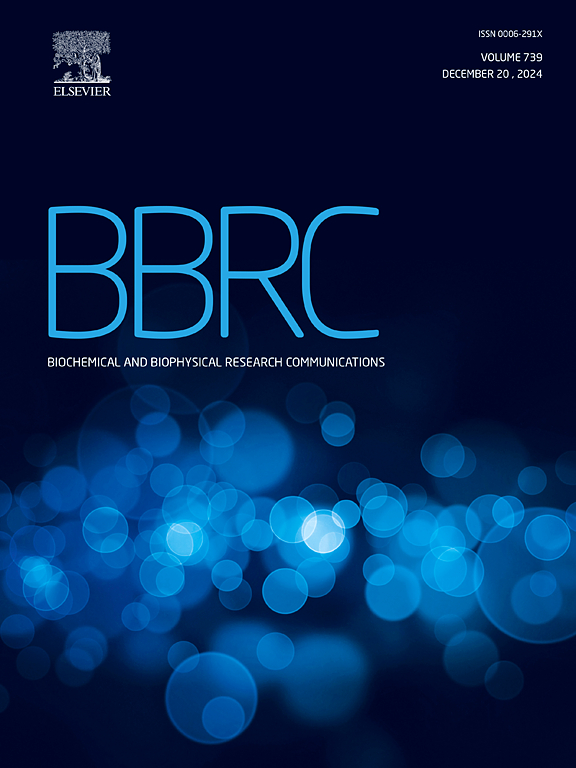The effect and mechanism of areca nut in ovarian cancer were investigated based on network pharmacology, molecular docking, and in vitro experiments
IF 2.5
3区 生物学
Q3 BIOCHEMISTRY & MOLECULAR BIOLOGY
Biochemical and biophysical research communications
Pub Date : 2025-05-08
DOI:10.1016/j.bbrc.2025.151943
引用次数: 0
Abstract
Background
Ovarian cancer ranks as the leading cause of death among gynecological malignancies[1, 2]. Areca nut has demonstrated notable antitumor activity, yet its underlying mechanism remains incompletely understood.
Objective
To explore the potential of areca nut - derived active ingredients in regulating ovarian cancer progression via the PTEN/AKT1 signaling axis.
Methods
Targets related to areca nut were screened from the TCMSP database, while ovarian - cancer - associated targets were retrieved from GeneCards and DisGeNET databases. Intersection targets were identified using Venn analysis. Core pathways were annotated through enrichment analysis with Metascape and DAVID databases. Molecular docking was performed to validate the binding energy intensity between areca nut active ingredients and their corresponding receptors. In addition, the effect of arecoline on ovarian cancer cells was investigated in vitro.
Results
A total of 50 common targets were identified from 139 areca nut - related targets and 1914 ovarian cancer - associated targets. Pathway enrichment analysis revealed significant enrichment of the PI3K/AKT pathway. The core targets, PTEN (−5.3 kJ/mol) and AKT1 (−5.4 kJ/mol), exhibited strong binding to the active components of areca nut. Moreover, arecoline inhibited the proliferation and induced apoptosis in ovarian cancer cells.
Conclusion
In conclusion, this study provides a solid scientific basis for exploring the action mechanism of areca nut.
采用网络药理学、分子对接、体外实验等方法,探讨槟榔对卵巢癌的作用及机制
卵巢癌是妇科恶性肿瘤中导致死亡的主要原因[1,2]。槟榔已显示出显著的抗肿瘤活性,但其潜在的机制尚不完全清楚。目的探讨槟榔果活性成分通过PTEN/AKT1信号轴调控卵巢癌进展的潜力。方法从TCMSP数据库中筛选槟榔相关靶点,从GeneCards和DisGeNET数据库中检索卵巢癌相关靶点。利用维恩分析法对交叉目标进行识别。通过metscape和DAVID数据库的富集分析,对核心通路进行了注释。通过分子对接验证槟榔有效成分与其受体之间的结合能强度。此外,我们还在体外研究槟榔碱对卵巢癌细胞的影响。结果从139个槟榔相关靶点和1914个卵巢癌相关靶点中共鉴定出50个共同靶点。通路富集分析显示PI3K/AKT通路显著富集。核心靶点PTEN(−5.3 kJ/mol)和AKT1(−5.4 kJ/mol)与槟榔果活性成分结合较强。槟榔碱抑制卵巢癌细胞增殖,诱导细胞凋亡。结论本研究为探索槟榔的作用机制提供了坚实的科学依据。
本文章由计算机程序翻译,如有差异,请以英文原文为准。
求助全文
约1分钟内获得全文
求助全文
来源期刊
CiteScore
6.10
自引率
0.00%
发文量
1400
审稿时长
14 days
期刊介绍:
Biochemical and Biophysical Research Communications is the premier international journal devoted to the very rapid dissemination of timely and significant experimental results in diverse fields of biological research. The development of the "Breakthroughs and Views" section brings the minireview format to the journal, and issues often contain collections of special interest manuscripts. BBRC is published weekly (52 issues/year).Research Areas now include: Biochemistry; biophysics; cell biology; developmental biology; immunology
; molecular biology; neurobiology; plant biology and proteomics

 求助内容:
求助内容: 应助结果提醒方式:
应助结果提醒方式:


